1991 年 1 月英语四级真题及答案
Part I Listening Comprehension (20 minutes)
Section A
Directions: Inthissection,youwillhear10shortconversations.Attheendofeach
conversation, a question will be asked about what was said. Both the
conversationandthequestionwillbespokenonlyonce.Aftereachquestion
therewillbepause.Duringthepause,youmustreadthefourchoicesmarked
A), B), C) and D), and decide which is the best answer. Then mark the
corresponding letter on the Answer Sheet with a line through the centre.
Example:
You will hear:
You will read:
A) At the office.
B) In the waiting room.
C) At the airport.
D) In a restaurant.
From the conversation we know that the two were talking about some work they had
to finish in the evening. This is most likely to have taken place at the office. There
fore, A) “At the office” is the best answer. You should choose [A] on the Answer Sheet
and mark it with a single line through the centre.
Sample Answer [A] [B] [C] [D]
1.
A) Bill always comes on time.
B) Bill will be on time.
C) Bill will be late again.
D) Bill won’t come.
2.
A) They don’t know how to spend the money they have.
B) They don’t know how to spend the next two weeks.
C) They need money badly.
D) They only have part-time jobs.
3.
A) One.
B) Two.
C) Three.
D) Four.
�
4.
A) These figures are not correct.
B) These figures are correct.
C) These figures are probably correct.
D) These figures are probably not correct.
5.
A) In October.
B) In April.
C) She isn’t certain.
D) Between April and October.
6.
A) Jane speaks three languages.
B) Jane speaks four languages.
C) Jane speaks English only.
D) Jane does not speak English.
7.
A) The damage to the store.
B) The possible harm to the people nearby.
C) The punishment given to the crazy man.
D) The reason for the crazy action.
8.
A) She is going to give up biology.
B) She spends half of her time on biology.
C) To her, biology is difficult, but math is not.
D) To her, math is even more difficult than biology.
9.
A) There was a shower.
B) There was a car accident.
C) There was a fire.
D) There was a heavy snow.
10. A) They are very rewarding.
B) They are too easy.
C) They are inexpensive.
D) They are not worth the trouble.
Section B
Directions: Inthissection,youwillhear3shortpassages.Attheendofeachpassage,
you will hear some questions. Both the passage and the questions will be
spokenonlyonce.Afteryouhearaquestion,youmustchoosethebestanswer
�
fromthefourchoicesmarkedA),B),C)andD),Thenmarkthecorresponding
letter on the Answer Sheet with a single line through the centre.
Questions 11 to 14 based on the passage you have just heard.
Passage One
11. A) The speaker’s friend.
B) The speaker.
C) The friend’s mother.
D) The mother’s friend.
12. A) They are strangers.
B) They are neighbours.
C) They are friends.
D) They are old schoolmates.
13. A) To return the shoes to the store.
B) To pay the manager a visit.
C) To buy more of the 12-dollar shoes.
D) To complain about the price of the shoes.
14. A) 12 dollars
B) 20 dollars
C) Less than 12 dollars
D) More than 12 dollars
Questions 15 to 17 are based on the passage you have just heard.
Passage Two
15. A) Short and cool.
B) Long and cool.
C) Long and hot.
D) Short and hot.
16. A) Because the price was too high.
B) Because Alaska has an extremely cold winter.
C) Because they thought Alaska was a useless land.
D) Because the climatic difference there is too great.
�
17. A) No, only a few became rich.
B) No, none became rich.
C) No, very few people had actually found gold.
D) Yes, hundreds of thousands of people became rich.
Questions 18 to 20 are based on the passage you have just heard.
Passage Three
18. A) She was driving along a country road.
B) She was lying near a lonely road, trembling.
C) She was lying in a hospital bed.
D) She was telling an astonishing story to a doctor.
19. A) She fainted due to the effects of some drug.
B) She was stopped by a policeman and treated rudely.
C) She was attacked by robbers.
D) She was stopped and forced to enter a flying saucer.
20. A) The women made up an astonishing story.
B) The women had intended to leave her husband without a word.
C) The women had been taken over a thousand miles away from her home.
D) The women had been dishonest to her husband.
Part II Reading Comprehension (35 minutes)
Directions: There are 4 passages in this part. Each passage is followed by some
questionsorunfinishedstatements.Foreachofthemtherearefourchoices
markedA),B),C)andD).Youshoulddecideonthebestchoiceandmarkthe
corresponding letter on the Answer Sheet with a single line through the
centre.
Passage One
Questions 21 to 25 are based on the following passage.
The aim of the teacher is to get his pupils as quickly as possible over the period
in which each printed symbol is looked at for its shape, and arrive at the stage when
the pupil looks at words and phrases, for their meaning, almost without noticing the
shapes of the separate letters.
When a good reader is at work he does not look at letters, nor even at words, one
by one however quickly; he takes in the meaning of two, three, or four words at a time,
in a single moment. Watch carefully the eyes of a person who is reading, and it will
�
be seen that they do not travel smoothly along the lines of print, but they move by
jumps separated by very short stops. The eyes of a very good reader move quickly, taking
long jumps and making very short halts(停顿); the eyes of a poor reader move more slowly,
taking only short jumps and stopping longer at each halt. Sometimes, when he meets a
difficulty, he even goes backwards to see again what has already been looked at once.
The teacher’s task is therefore clear: it is to train his pupils to take in several
words at a glance (one eye-jump’) and to remove the necessity for going backwards to
read something a second time.
This shows at once that letter-by-letter, or syllable-by-syllable, or word-by-word
reading, with the finger pointing to the word, carefully fixing each one in turn, is
wrong. It is wrong because such a method ties the pupil’s eyes down to a very short
jump, and the aim is to train for the long jump. Moreover, a very short jump is too
short to provide any meaning or sense; and it will be found that having struggled with
three or four words separately, the pupil has to look at them again, all together and
in one group, in order to get the meaning of the whole phrase.
21. Which of the following is closest in meaning to the first paragraph?
A) Pupils should be trained to reach quickly the stage of reading without having
to concentrate on the separate symbols.
B) Pupils should look at each printed symbol for its meaning as well as for its
shape.
C) Teachers should help their pupils avoid looking at the shape of the printed
symbols.
D) Teachers should tell their pupils the different stages of their study.
22. In a single moment, a good reader picks up ________.
A) several words
B) several phrases
C) several sentences
D) several lines
23. According to the passage, which of the following is FALSE?
A) The eyes of a good reader make short halts and long jumps.
B) The eyes of a bad reader take in the meaning of one word at a time.
C) The eyes of a bad reader take only short jumps.
D) The eyes of a good reader move steadily.
24. One may have to read something a second time if ________.
A) there is enough time
B) one reads too fast
�
C) the passage is very long
D) one reads word by word
25. The main idea of the last paragraph is that ________.
A) word-by-word reading is highly inefficient
B) the pupil’s eyes should focus on groups of syllables instead of single syllables
C) pupils have to move their eyes back and forth when reading
D) finger pointing in reading helps the pupil concentrate on meaning
Passage Two
Questions 26 to 30 are based on the following passage.
Television has changed the lifestyle of people in every Industrialized country in
the world. In the United States, where sociologists have studied the effects, some
interesting observations have been made.
Television, although not essential, has become an important part of most people’s
lives. It alters peoples’ ways of seeing the world; in many ways, it supports and
sustains (维持) modern life. Television has become a baby-sitter, an introducer of
conversations, the major transmitter of culture, a keeper of tradition. Yet when what
can be seen on TV in one day is critically analyzed, it becomes evident that television
is not a teacher but a sustainer; the poor quality of programming does not elevate(提
高) people into greater understanding, but rather maintains and encourages the life
as it exists.
The primary reason for the lack of quality in American television is related to
both the history of TV programming development and the economics of TV. Television in
America began with the radio. Radio companies and their sponsors first experimented
with television. Therefore, the close relationship which the advertisers had with radio
programs became the system for American TV. Sponsors not only paid money for time within
programs, but many actually produced the programs.
Thus, in American society, television is primarily concerned with reflecting and
attracting society rather than experimenting with new ideas. Advertisers want to
attract the largest viewing audience possible, to do so requires that the programs be
entertaining rather than educational, attractive rather than challenging.
Television in America today remains, to a large extent, with the same organization
and standards as it had thirty years ago. The hope for further development and true
achievement toward improving society will require a change in the entire system.
26. According to the author American television is poor in quality because ________.
A) advertisers are interested in experimenting with new ideas
B) it is still at an early stage of development, compared with the radio
C) the programs have to be developed in the interests of the sponsors for economic
�
reasons
D) it is controlled by radio companies
27. The second paragraph is mainly about ________.
A) TV as the sustainer of American life
B) TV as the major transmitter of culture
C) the educational effect of TV on society
D) the strong influence and the poor quality of American TV
28. In the author’s view American TV should ________.
A) be critical but entertaining
B) be creative and educational
C) change with the development of society
D) attract as many viewers as possible
29. The author believes that television in the United States has become important to
most people because ________.
A) it promotes family unity
B) it helps them develop their speaking ability
C) it affects their life in many ways
D) it challenges society
30. The author’s attitude towards American television is ________.
A) critical
B) praising
C) doubtful
D) sympathetic
Passage Three
Questions 31 to 35 are based on the following passage.
“... We are not about to enter the Information Age but instead are rather well
into it.” Present predictions are that by 1990, about thirty million jobs in the United
States, or about thirty percent of the job market, will be computer-related. In 1980,
only twenty-one percent of all United States high schools owned one or more computers
for student use. In the fall of 1985, a new survey revealed that half of United States
secondary schools have fifteen or more computers for student use. And now educational
experts, administrators, and even the general public are demanding that all students
become “computer literate(慢点…的).” “By the year 2000 knowledge of computers will
be necessary in over eighty percent of all occupations. Soon those people not educated
�
in computer use will be compared to those who are print illiterate today.”
What is “computer literacy”? The term itself seems to imply soon extent of
“knowing” about computers, but knowing what. The current opinion seems to be that
this should include a general knowledge of what computers are, plus a little of their
history and something of how they operate.
Therefore, it is vital that educators everywhere take a careful look not only at
what is being done, but also at what should be done in the field of computer education.
Today most adults are capable of utilising a motor vehicle without the slightest
knowledge of how the internal-combustion engine works. We effectively use all types
of electrical equipment without being able to tell their histories or to explain how
they work. Business people for years have made good use of typewriters and adding
machines, yet few have ever known how to repair them. Why, then, attempt to teach
computers by teaching how or why they work?
Rather, we first must concentrate on teaching the effective use of the computer
as the tool is.
“Knowing how to use a computer is what’s going to be important, we don’t talk
about ‘automobile literacy. ‘ We just get in our cars and drive them.”
31. In 1990, the number of jobs having nothing to do with computers in the United States
will be reduced to ________.
A) 79 million
B) 30 million
C) 70 million
D) 100 million
32. The expression “Print illiterate” (Para. 1, Line 16) refers to ________.
A) one who has never learnt printing
B) one who is not computer literate
C) one who has never learnt to read
D) one who is not able to use a typewriter
33. The first paragraph is mainly about ________.
A) recent predictions of computer-related jobs
B) the wide use of computers in schools
C) the urgency of computer education
D) public interest in computers
34. According to the author, the effective way to spread the use of computers is to
teach ________.
A) what computers are
�
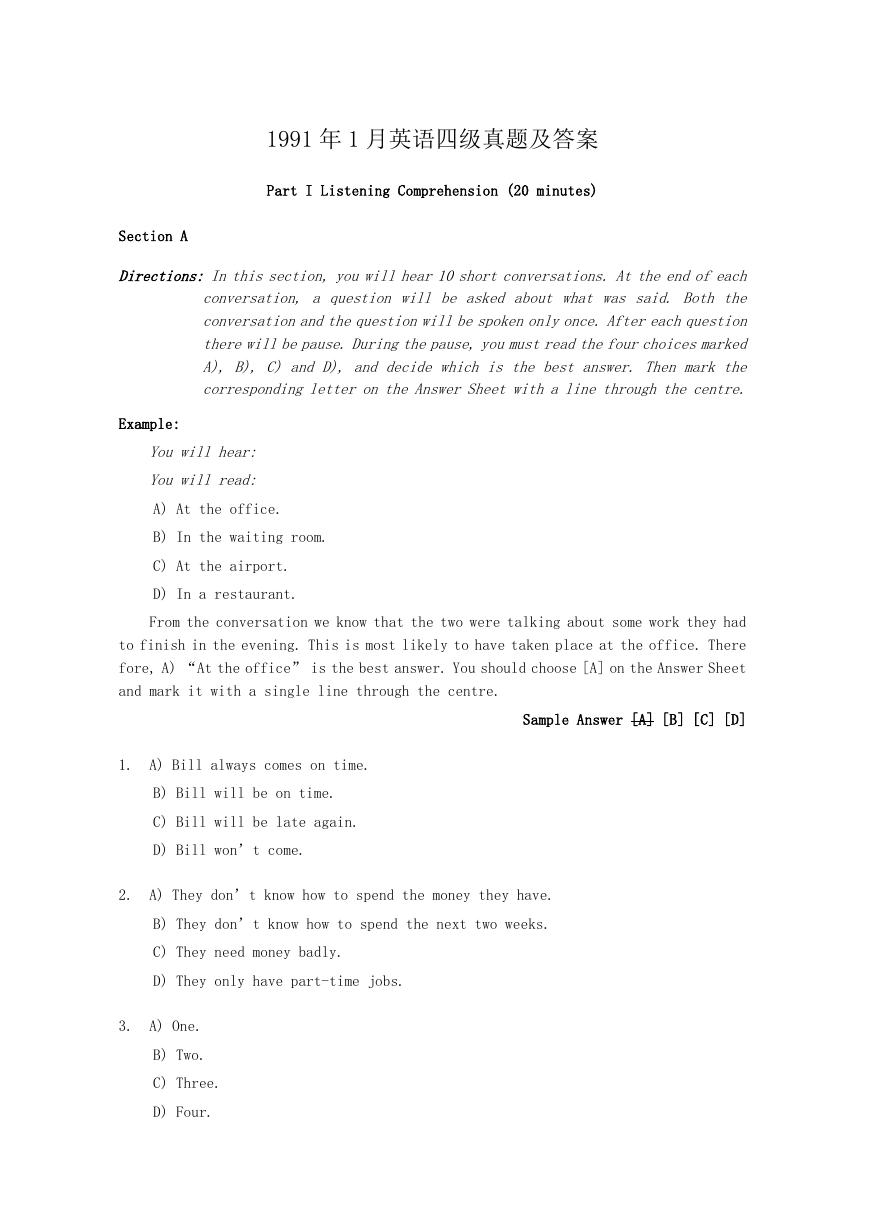


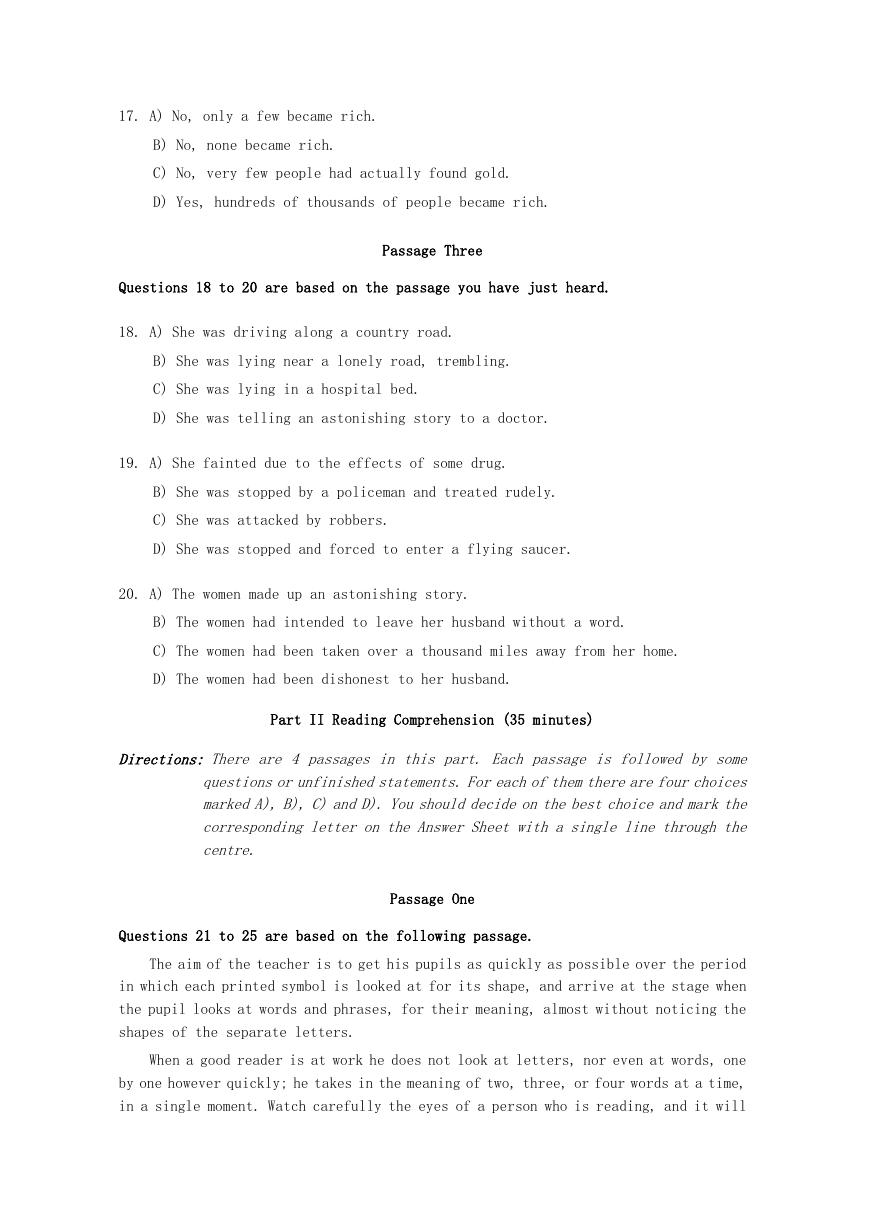

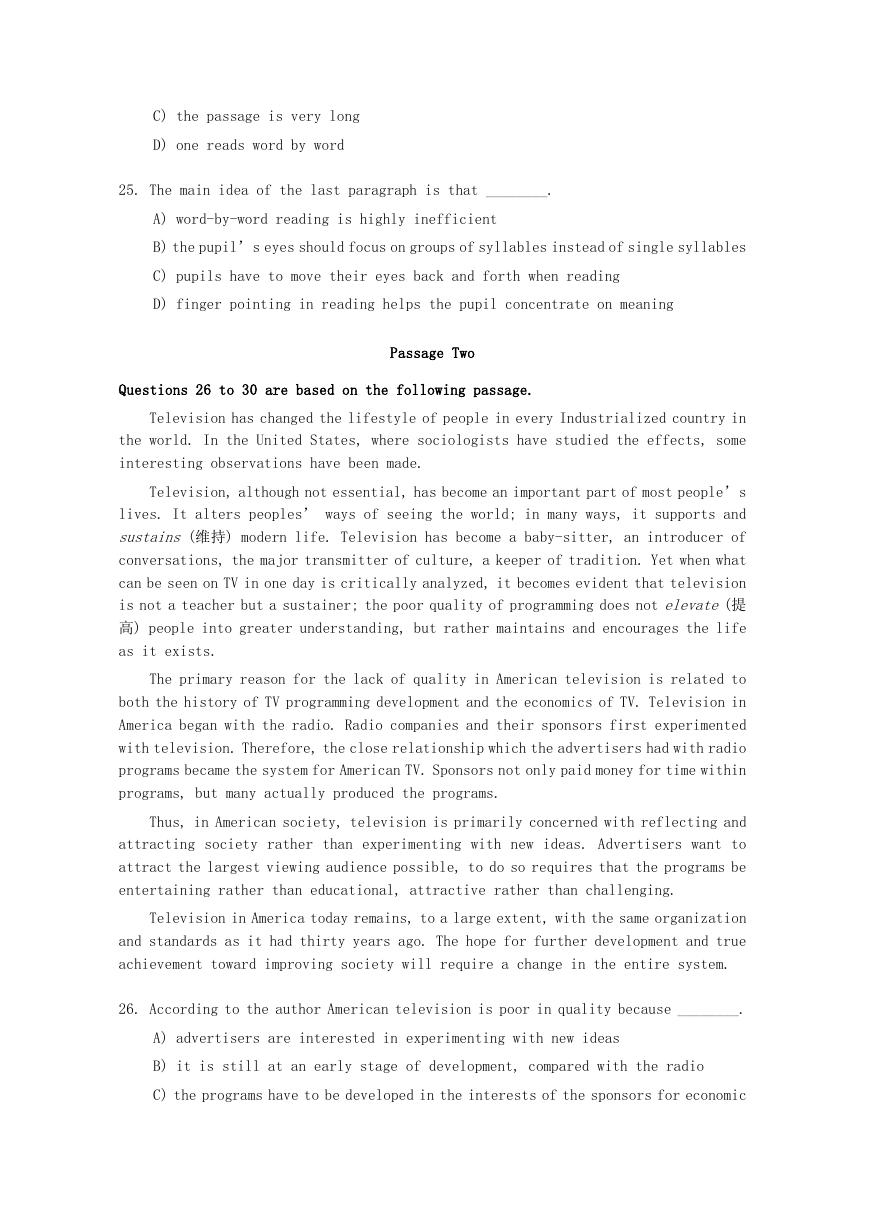
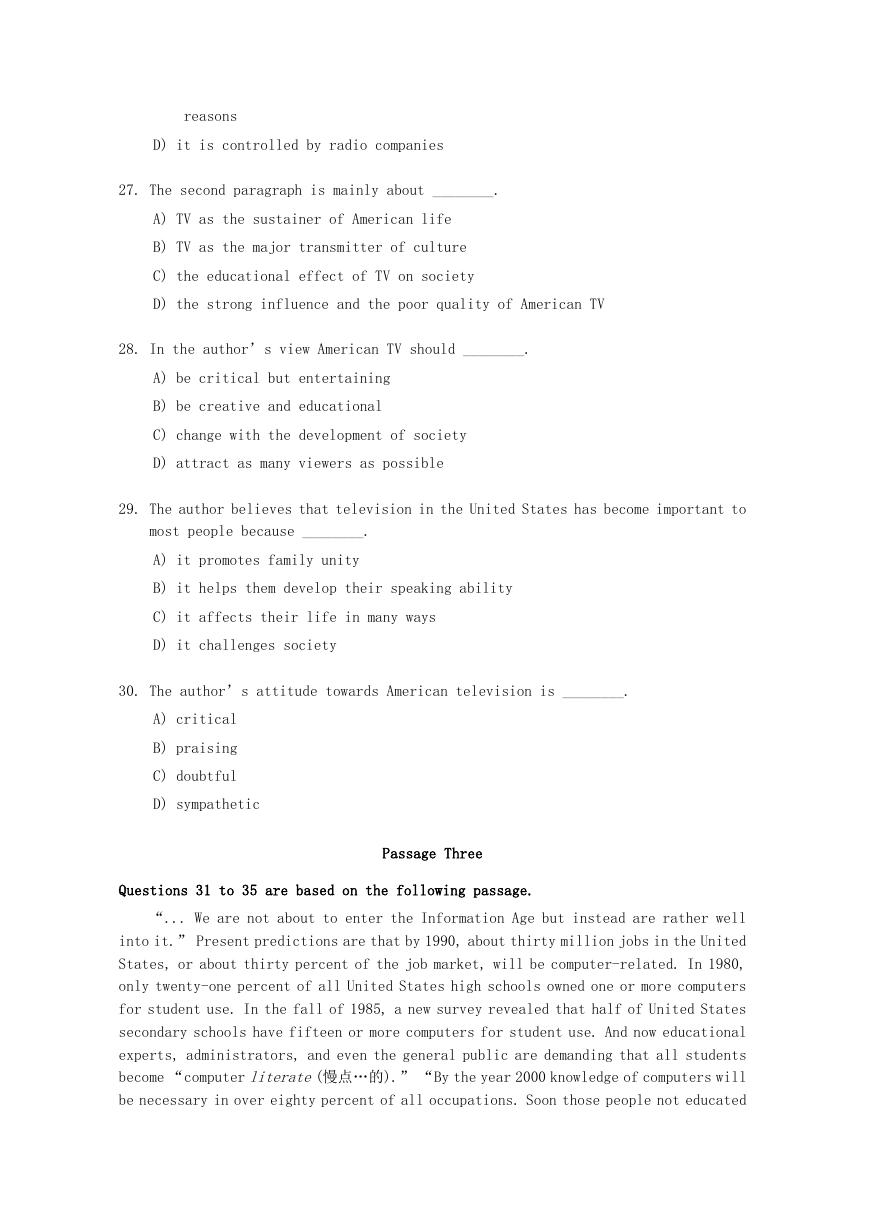
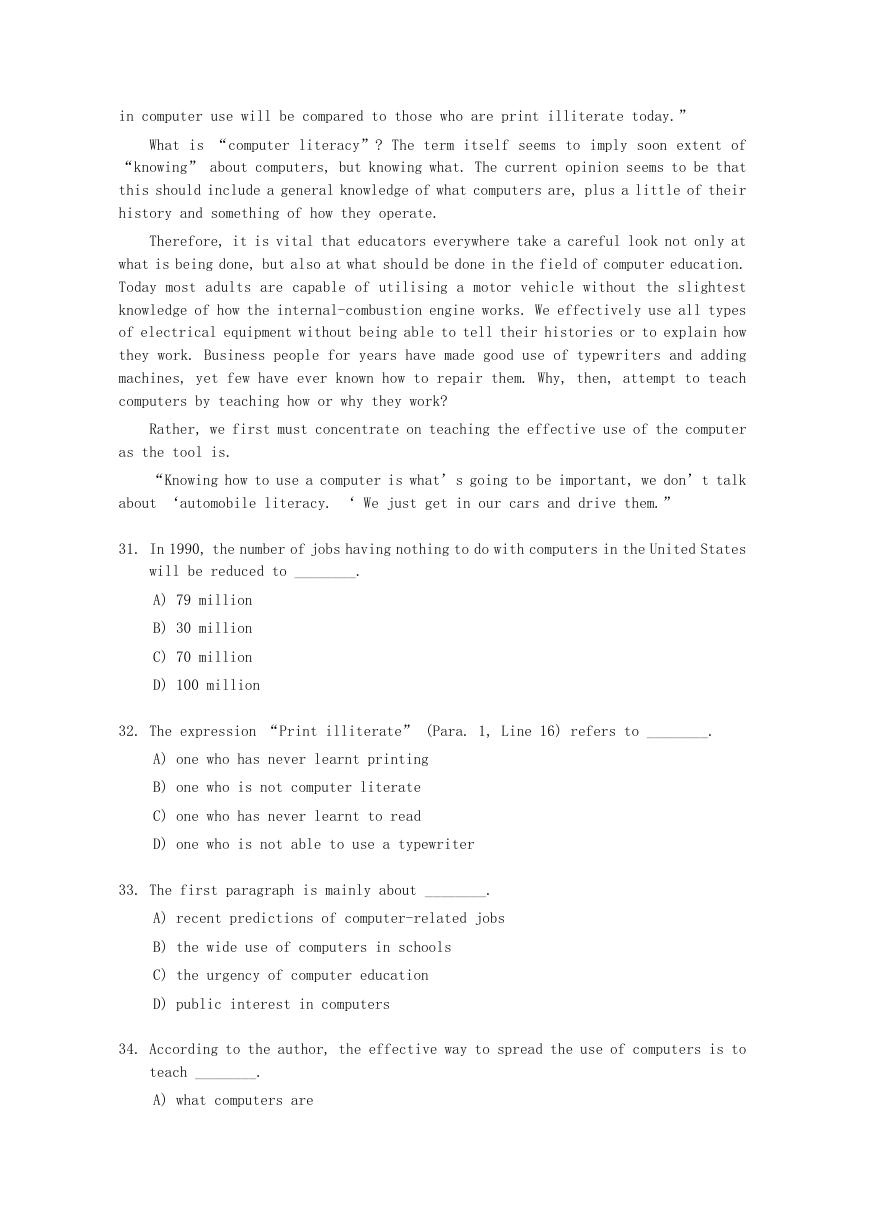








 2023年江西萍乡中考道德与法治真题及答案.doc
2023年江西萍乡中考道德与法治真题及答案.doc 2012年重庆南川中考生物真题及答案.doc
2012年重庆南川中考生物真题及答案.doc 2013年江西师范大学地理学综合及文艺理论基础考研真题.doc
2013年江西师范大学地理学综合及文艺理论基础考研真题.doc 2020年四川甘孜小升初语文真题及答案I卷.doc
2020年四川甘孜小升初语文真题及答案I卷.doc 2020年注册岩土工程师专业基础考试真题及答案.doc
2020年注册岩土工程师专业基础考试真题及答案.doc 2023-2024学年福建省厦门市九年级上学期数学月考试题及答案.doc
2023-2024学年福建省厦门市九年级上学期数学月考试题及答案.doc 2021-2022学年辽宁省沈阳市大东区九年级上学期语文期末试题及答案.doc
2021-2022学年辽宁省沈阳市大东区九年级上学期语文期末试题及答案.doc 2022-2023学年北京东城区初三第一学期物理期末试卷及答案.doc
2022-2023学年北京东城区初三第一学期物理期末试卷及答案.doc 2018上半年江西教师资格初中地理学科知识与教学能力真题及答案.doc
2018上半年江西教师资格初中地理学科知识与教学能力真题及答案.doc 2012年河北国家公务员申论考试真题及答案-省级.doc
2012年河北国家公务员申论考试真题及答案-省级.doc 2020-2021学年江苏省扬州市江都区邵樊片九年级上学期数学第一次质量检测试题及答案.doc
2020-2021学年江苏省扬州市江都区邵樊片九年级上学期数学第一次质量检测试题及答案.doc 2022下半年黑龙江教师资格证中学综合素质真题及答案.doc
2022下半年黑龙江教师资格证中学综合素质真题及答案.doc